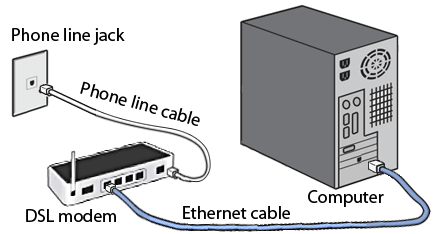What is the full form of DSLDSL: Digital Subscriber LineDSL stands for Digital Subscriber Line. DSL is a communication medium used to transfer high-speed internet over a standard copper wire telecommunication line. DSL offers the best cost, connectivity and services over other internet access types like broadband. Data transfer and telephone conversation can be made simultaneously over a DSL. Over the 'voiceband' frequency range, a voice signal is transmitted using low frequencies (0Hz to 4kHz). In comparison, digital signals are transmitted through high frequencies (25kHz to 1.5MHz). To make sure that phone call does not get interrupted by high frequencies, DSL filters or splitters are used. 
Types of DSL
Features
What is DSL's Process?DSL uses traditional phone signals and outdated copper telephone lines to transmit digital data, such as internet downloads and uploads and VoIP conversations. Dial-up internet prevents phone signals from using the connection because it operates at frequencies distinct from those used by phone signals. Due to the fact that DSL does not affect phone service, it may be a viable always-on solution. There are several internet service providers that offer DSL networks. This does not mean that DSL providers just offer DSL, though. Oftentimes, the same provider will operate many types of internet networks, including DSL, cables, and fibre. The services a supplier offers may change based on where your company is situated. Human voices speaking in typical conversational tones have a frequency range of 0 to 3,400 Hertz. This is a very small frequency range. Contrast this to the typical stereo speaker's frequency range, which is between 20 and 20,000 Hz. Most of the time, the wires can handle frequencies up to many million Hertz. The consumption of such a small portion of the total bandwidth of the cable is historical. Keep in mind that copper wires have been going into every home for over a century to power the phone system. The telephone system can accommodate numerous wires in a small space without causing interference by limiting the frequencies that are transmitted through the cables. The capacity of the phone line may be much more safely used by modern technology that carries digital data rather than analogue data. That is exactly what DSL does. One piece of hardware is needed at the customer's end of the DSL connection, while the other is needed at the internet service provider, phone company, or other DSL service provider. A DSL transceiver that may also provide add-on services is present at the customer's location. A DSL Access Multiplexer (DSLAM) is carried out by the DSL network operator to accept client connections. Right now, DSL modems collect signals via phone lines and convert them into digital data for your use. It is possible to send this data wirelessly or through an Ethernet connection. DSL is made available in both urban and rural areas by utilizing existing telephone lines. DSL signals may just share the same infrastructure, as phone signals as phone lines have more capacity than is required for phone calls. Independent devices that may link a number of PCs or mobile devices together are DSL modems or routers. DSL technology won't interfere with your landline phone connection because of its unique operating frequencies. There is a chance that phone and internet networks will coexist. Several things affect how symmetric and asymmetric DSL connections work. In order to provide equal data transmission and reception speeds, symmetric DSL (SDSL) splits the upstream and downstream streams equally. Most of the time, individuals would rather consume data than upload it. In such cases, service providers provide asymmetric DSL (ADSL) services. A bigger frequency range is made available by ADSL service for downloads via computer networks, frequently leading to substantially higher downstream rates. Strictly speaking, an SDSL connection may provide 2 Mbps of downstream and 1.5 Mbps of upstream bandwidth, whereas an ADSL connection may provide 20 Mbps of downstream and 1.5 Mbps of upstream bandwidth.
Next TopicFull Form
|
 For Videos Join Our Youtube Channel: Join Now
For Videos Join Our Youtube Channel: Join Now
Feedback
- Send your Feedback to [email protected]
Help Others, Please Share










